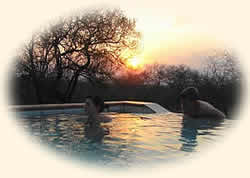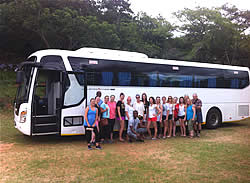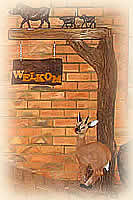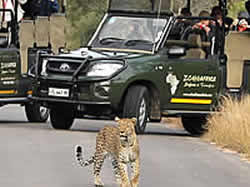In 1898 President Paul Kruger proclaimed the area between the Crocodile and Sabie Rivers as the Sabie Reserve because hunting mania had wiped out the Lowveld's huge herds of game.
After the Anglo-Boer war, the British began clearing the way for the protected areas by the forced removal of between 2000 -3000 local inhabitants in1903.
These removals continued throughout the Kruger's history. In 1969 the Makukeke people were moved out of the Pafuri area. The dispute over land claims continues today.
Major James Stevenson-Hamilton was appointed the first warden. He was a short, quick-tempered Scotsman and was given the African name "skukuza" meaning "he who turns things upside down". He waged constant war against poachers and was responsible for expanding the Kruger Park, incurring the wrath of local farmers who felt that the Reserve was a breeding ground for lions. Both domestic stock and people were often attacked.
Piet Grobler, Minister of Lands in 1926 successfully passed the Bill on National Parks and named the area Kruger National Park
In 1927, three cars entered the Park. Two years later there were 850 cars. Over the next 50 years, 150 000 people visited the Park annually. Today, 700 000 people visit the Park every year.
The Kruger National Park was established in 1926. The surface area of Kruger National Park is 7,580 miles² (19,633 km²).
- There are almost 254 known cultural heritage sites in the Kruger National Park, including nearly 130 recorded rock art sites.
- There is ample evidence that prehistoric man - Homo erectus roamed the area between 500 000 and 100 000 years ago
- Cultural artifacts of Stone Age man have been found for the period 100 000 to 30 000 years ago.
- More than 300 archaeological sites of Stone Age man have been found
- Evidence of Bushman Folk (San) and Iron Age people from about 1500 years ago is also in great evidence.
- There are also many historical tales of the presence of Nguni people and European explorers and settlers in the Kruger area.
- There are significant archaeological ruins at Thulamela and Masorini
- There are numerous examples of San Art scattered throughout the park.
- The park was first proclaimed in 1898 as the Sabie Game Reserve by the then president of the Transvaal Republic, Paul Kruger. He first proposed the need to protect the animals of the Lowveld in 1884, but his revolutionary vision took another 12 years to be realised when the area between the Sabie and Crocodile Rivers was set aside for restricted hunting.
- The Scottish born James Stevenson-Hamilton (born in 1867) was appointed the park's first warden on 1 July 1902.
- In 31 May 1926 the National Parks Act was proclaimed and with it the merging of the Sabie and Shingwedzi Game Reserves into the Kruger National Park.
The first motorists entered the park in 1927 for a fee of one pound.
- Many accounts of the park's early days can be found in the Stevenson-Hamilton Memorial Library Ref : http://www.sanparks.org/parks/kruger
|
DESCRIPTION OF ACCOMMODATION TYPES
Kruger National Parks offers camp-run accommodation. Each camp has its own unique selection of accommodation types: Back to top
Camping
Sites for caravans or tents - most have power (except Balule and some at Punda Maria). Sites at lower Sabie have designated boundaries and own water taps.
Hut
Single room units with communal kitchen and communal ablution facilities.
Safari Tent
Permanent canvas tent bedrooms on permanent platforms. Some have communal kitchen and communal ablution facilities, while others are fully equipped and have more luxurious trimmings.
Bungalow
Single bedroom units with a bathroom. Some have communal kitchens while others have own kitchenettes with basic kitchen equipment. Some bungalows have perimeter or river views, while others have been upgraded to luxury status.
Cottage
Single bedroom units with living room, bathroom and kitchen.
Family Cottage
Multiple bedroom units with a living room, bathroom and kitchen.
Guest Cottage
Multiple bedroom units with at least 2 bathrooms of which one is en-suite. Fully equipped kitchen.
Guest House
Multiple bedroom and bathroom units with lounge area and often with bar facility and exclusive view.
Bush Lodge
Exclusive private lodges, with a unique style and atmosphere. Multiple rooms and bathrooms.
Main Restcamps
All the major restcamps have electricity, a first-aid centre, a shop, braai and communal kitchen facilities, a laundromat/laundry tubs, a restaurant and/or self-service cafeteria, public telephones and a petrol station. Information centres manned by information staff are at Letaba, Skukuza and Berg-en-Dal. Holiday programmes and evening film shows of wildlife and conservation are arranged in many of the restcamps. Please enquire at reception
|
|
|
THE WILDLIFE OF KRUGER NATIONAL PARK - REFERENCED WITH PERMISSION FROM HTTP://WWW.LJTOURS.COM |
Buffalo |
 |
Hunters in general regard a wounded buffalo as being one of the most dangerous animals. Once a buffalo charges, only a well-placed bullet from a heavy caliber rifle can stop it. A charging buffalo presents a very difficult target for a brain shot and the massive horn bosses often deflect the bullet. It is claimed that a buffalo can attain a speed of 50km/h. When not threatened, they are harmless, but their tendency to stampede when alarmed could be dangerous if one happens to be in the way. Their major enemy is the lion, but even lions stand a good chance of losing their lives when attacking a buffalo as it will go down fighting to the last breath. When a herd is threatened by lions, it will form a protective circle with the bulls on the perimeter. Lions usually try to stampede the herd so that one is separated and is then attacked. Buffalo sometimes fall prey to crocodiles and young animals may be killed by other larger predators. Figures indicate that only 6-9 calves out of every 20 born reach maturity. A single calf is born after a gestation period of about 330-346 days.Buffalo harbor foot- and- mouth disease, as well as "Buffalo" or "Corridor Disease". This is transmitted to domestic stock via the Brown Ear Tick. There is no treatment, cure or prophylactic against this disease. Many buffalo are also infected with tuberculosis. Natal Game Ranchers' Association, in conjunction with Natal Parks Board, have embarked on a programme to breed genetically disease-free buffalo. |
Chacma Baboon |
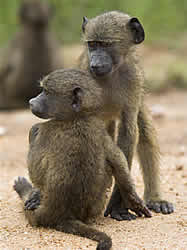 |
The average size of a baboon troop is 30 -40 but may vary from 10 -100 or more. Baboons are very cunning and intelligent. They are gregarious and have strong social ties. Communication by sounds and "body language" is highly developed.
A cornered baboon will attack and if a young one is being threatened by a predator or disturbed by a human being, the adult males will attack fiercely. They are omnivorous and eat roots, tubers, fruit, berries, insects, scorpions and bird's eggs. Occasionally they attack and kill small antelope and lambs. Baboon females are excellent mothers and will defend their young fiercely.
Males are even more aggressive in this respect. A single baby is born after a gestation period of 6-7 months.
If an infant dies, the mother often carries the tiny corpse with her for a week or more, despite its advanced decomposition. Leopard and lion are their major enemies.
Other enemies include eagles, pythons (of which they have an instinctive fear) crocodiles and possibly caracals. |
Cheetah |
 |
The name probably comes from an Indian wod "chita", meaning "spotted one". Cheetah are gracefuly, long-legged members of the cat family. They have a relatively small head, a long, rather bushy tail which is white at the tip. Their beautiful tawny coat has small, roundish black spots, spread evenly over the body. Conspicuous dark lines run from the front of the eyes to the upper lip. A small mane along the top of the shoulders is ofter visible. Its whole anatomy is adapted for speed. Cheetas are true cats, in spite of the fact that they cannot retract their claws. However, as cubs they can do so, and the loss of this ability in later life is just an adaptation for running.Due to their method of hunting, Cheetah prefer fairly open to lightly-wooded savanna, where visibility is good. They can also survive in semi-deserts as well as fairly thick bush. It is commonly accepted that an adult cheetah in its prime can reach speeds in excess of 100km/h, but this can only be sustained over short distances as cheetahs have very little stamina.Hunting in a group is common. The prey is knocked off balance with a backward pull by the cheetahs claws. The teeth are used only to kill the prey after is has been knocked down. Death of the prey is, in most cases, due to strangulation. They are among the most timid of predators. When water is available, they drink regularly, but in arid conditions like the Kalahari, they can go for considerable periods without water. The geatation period is from 90 - 95 days. Between 2 and 6 cubs are born - the average being 4. For the first 8 weeks the female hides her cubs very well, but still, about half of the cubs die within the first few months of life. Small cubs are vulnerable to eagles, hyenas, leopards and lions. Diseases such as cat flu and rickets probably also play an important role. The young usually stay with the mother up to the age of about 2 years. Cheetahs are trustworthy and in fact make excellent pets. However, the keeping of cheetahs as pets is prohibited in South Africa. |
Elephants |
 |
In 1898 there were no elephant left in the old Sabie Game Reserve. Small numbers migrated between Shingwedzi and Mozambique. Around 1912, Stevenson-Hamilton reported a resident herd of about 25 elephants along the Shingwedzi River. However, large numbers of elephants entered the Kruger Park from Mozambique before the completion of the elephant-proof fence in 1976. Elephants browse and graze on many different plant species. Bark of trees, fruit, roots and herbs are also consumed. It is estimated that they consumed an average of 200 kg of food per day, feeding close on 18 hours out of 24 per day. Large bulls drink up to 350 litres of water at a time. They can dig holes in sandy riverbeds up to 1,8 m deep. Elephants are able to walk extremely quietly through the bush due to the thick padding covering the soles of their feet. This prevents them slipping and deadens the sound of twigs trampled underfoot.
The tusks are used for defense, digging up roots and stripping bark from trees. At about 60 years of age, only a fragment of the last molar tooth remains in each half of the jaws. At this stage, chewing becomes progressively more ineffective and starvation is the animal's fate. Elephants do not tolerate other animals at a waterhole. A number of zebras and other game have been killed by them. They lash the animal with their trunks, breaking its back. Even lions will flee "with their tails between their legs" when elephant arrive at the waterhole. The gestation period usually lasts for about 22 months. The cow has two teats situated between the front legs. The calf suckles with its mouth while the trunk is bent over backwards or to the side. Calves are very well protected against predators, and the only real enemy of the elephant is man. |
Giraffes |

|
In early times, people thought the giraffe was a cross between a camel and a leopard. This led to the word "camelopardalis". The Arabs called it "xirapha" which means "one who walks fast" The graceful giraffe hase some fascinating features and habits. Giraffes are normally browsers and feed on, amongst others, the tamboti tree, which is very poisonous to human beings. Combretum seeds, also poisonous, are taken frequently. Giraffes can go for long periods without drinking water but will drink regularly if water is freely available. A big bull may drink up to 25 litres of water a day. In spite of its long neck, the giraffe has only 7 neck vertebrae, like most other mammals. Although their hearts are not exceptionally big in comparison to other mammals, they are very strong. The blood pressure at the heart is about 260/160 compared to 120/80 in a healthy human. The neck arteries have valves to prevent the blood flowing abruptly away from the brain when it lowers its head to drink. Giraffes are the only mammals that have valves in arteries. The horns seem to serve no real purpose but are used by the males in fights. However, they appear to do no real harm. It is possible to identify the sex of the giraffe even if only the head is visible because the females' horns are shorter and more slender and have tufts of hair at the tips. The tips of the bulls' horns are bare. No individual giraffe has identical markings. They usually become darker with age and this is more pronounced in the males. Giraffes can run at approximately 48 km/h and keep up a brisk pace over a distance of up to 7 km. The gestation period is about 457 days. The mother-calf relationship is very loose and when the calf is about 6 weeks old, the mother no longer defends it. It has to watch and follow her when she moves or flees from danger. Because of this, the calf mortality is very high - it can be up to 48%. |
Hyenas |
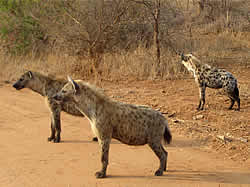 |
Hyenas are about the size of a large, powerfully-built dog and have sloping backs, broad heads, thick muscular necks and well-developed forequartes. They are incredibly cunning and intelligent animals. Hyenas are scavengers, but if the need arises they do kill their own prey, and they are extremely resourceful and formidable predators. they are, however, arch opportunists and will never over-exert themselves if their is the least chance of them obtaining carrion left by other predators, or where they find it feasible to rob a lessor predator of a kill.They hunt both singly, or in packs. They do not run very fast and may not be able to exceed 50km/h, but they have immense stamina and can maintain their pace for long distances. A large pack of hyena can pull down adult wildebeest, zebra, waterbuck and kudu. They also demonstrate an uncanny ability to select vulnerable prey such as sick or disabled animals. They have tremendously powerful jaws and can crush and eat even the thigh bones of buffalo. Hungry hyenas ofter take incredible risk to snatch meat from a hungry lion. Often they are killed as result of this.One of the most typical sounds in the African bush, is the long draw-out wail of the hyena. They also have and eerie, maniacal "laugh" which builds into a wild cacophany of sound. The gestation period is about 110 days. Two or three pups are usually born in a burrow dug by the mother, and remain underground for the first six weeks. Pups fall prey to other predators and even pythons, but man is one of the hyena's greatest enemies. Sexual maturity is reached at about three years of age, and they can live up to 20 years. There is widespread belief that hyenas can change from one sex to the other, but this is untrue. This fallacy probably arose because it is difficult to distinguish sexual differences. There are many superstitions about hyenas in the Africa bush. Witch doctors use the tails, whiskers, lips and genitals for certain potions. |
Leopards |
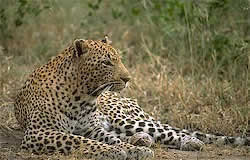 |
Leopards are predominantly nocturnal and very covert by nature. They are extremely difficult to spot. Their prey ranges from rats to fully-grown wildebeest. Baboons rank high on their preference list. They lie in ambush or stalk their prey and then pounce on it. They are extremely efficient hunters. However it has been reported that leopards have been killed by baboons when they have rashly attempted to snatch a baboon from a troop in broad daylight. When this happens, a number of adult male baboons usually go to the aid of the victim and attack the leopard. In spite of its elusiveness, the leopard is a bold and courageous animal that will not hesitate to attack when cornered or in danger. It is said that it will attack humans encountered in the bush, more readily than a lion. Leopards do not roar - they make coarse grunting sounds, growl and snarl. Gestation is about 150 days and there are usually 1-3 cubs born. The mother hides her cubs for a number of weeks before they accompany her. Cubs left alone by the mother could fall prey to hyena, wild dogs and even lion. Poaching poses a problem to the survival of the leopard. However, their population is probably at a stable level at the moment. |
Lions |
 |
The king of the beasts. They are indeed an awesome sight from close-up. It is the most sociable member of the cat family, living in prides of 3-30 individuals. The prides normally consist of 1-4 adult males, several adult females - one of which is dominant - and a number of sub-adults and cubs. The females undertake most of the hunting, and despite the fact that the males play little part in most kills, they feed before the females. Lions normally kill only to sustain themselves, but the are opportunists and will occasionally kill much more than they can consume. Normally giraffe are the largest prey attacked by lions. A healthy full-grown hippo or rhino is more than a match for a lion. However, they will attack weakened hippo on land or diseased or disabled rhino. Small animals are usually swatted down and then grabbed with both paws, with the killing bite directed at the back of the neck, throat, head or chest. Larger prey often die from strangulation, suffocation or loss of blood. They usually hunt at night or during the cooler part of the day. Lions have been killed by Sable Antelope, Kudu, Buffalo, giraffe, snakes and porcupines. When a lion attempts to kill a porcupine, the quills may become lodged in the paws or mouth, causing death from infection or starvation. A lion is deceptively fast over short distances. Claims of up to 80 km/h have been made but not proved. Lions can climb trees far better than humans. Their sense of small is good and their senses of hearing and sight are excellent. The roar of a lion can be heard up to 8 km away. Lions do not take to water as readily as tigers or jaguars, but they can swim and it is not uncommon for them to cross a river. The gestation period is 100-114 days. The average litter is 2 -3 cubs. A mating pair usually leaves the pride for one to three days. The lion's virility is amazing. |
Sable antelope |
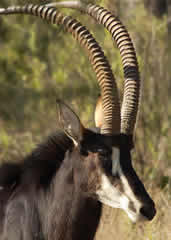
|
Sable antelope are one of the most beautiful species of antelope found in the Park. They are gregarious, running in herds of between 10 to 40.
The average herd size is 14. Usually the herd consists of a number of cows and calves and one large bull. The dominant cow leads the herd. Young bulls are evicted from the herd by the dominant bull when they are between 2-3 years of age.
Sable rarely associate with other game species. They will mingle at the waterhole, but move away when they are finished. These beautiful animals can be very dangerous and will charge with little provocation when wounded or at bay.
A full-grown Sable has been known to kill a lion when under attack. Cows and calves are more vulnerable and are preyed upon by leopard, cheetah and even wild dogs. A single calf is born after a gestation period of about 240 days. |
Rhino - Black |
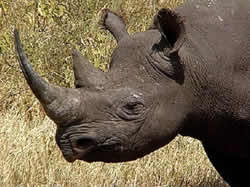
|
The rhino looks prehistoric and, indeed, they do have a long prehistory. They have probably existed in their current form for many millions of years. At one stage, black rhino were extinct in the Park. 20 were brought from Natal (now Kwa-Zulu Natal) in1971, 12 from Zimbabwe in 1972 and a further 38 from Natal, starting in1977 and again in 1980-1982. Black rhino are browsers while white rhino are grazers. They have a pointed, prehensile upper lip suited to browsing compared to the broad square lip of the grazing white rhino. The horns of the rhino are not true horns. They are outgrowths of the dermal papillae, which resembles compressed hair. They do not have bony cores and bony sheaths. In spite of their tremendous bulk, rhinos are agile and attain speeds of between 30-40 km/h. They are very shortsighted and rely on their excellent sense of smell and fairly well developed hearing. A very strong bond exists between mother and calf. The mother will defend her calf fiercely. The calves usually remain with the mothers until they are sexually mature, even if she has another calf. The black rhino calf runs behind its mother while the white rhino calf runs ahead. Although the black rhino has been singled out as one of the most unpredictable and short-tempered of beasts, it is not as dangerous as is generally believed. However, it is aggressive and temperamental and should be treated with caution. Man remains the greatest enemy of the rhino. Powdered rhino horn is regarded as an aphrodisiac by many people from Africa and the Orient. The rhino's prolonged sex act, which may last for more than half an hour, probably gave rise to this strange belief. The gestation period is approximately 450 days. |
Rhino - White |
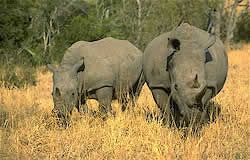 |
By 1920 it was claimed that only 20 white rhino were left in South Africa, all of them confined to parks in Natal - now know as Kwazulu Natal. By approximately 1970, they surpassed the 1000 mark. They are now found in a number of parks in South Africa. The white rhino is the second largest land animal. They have a long pre-history and probably existed in their current form for many millions of years. They are a bulky animal with a pronounced hump of the neck. The head is carried low and the front horn is noticeably longer than the rear one. they are grey to dark grey. Although they are called "white" rhino, this really has nothing to do with their colour. The most accepted explanation for the name is that the word "wydmond" (meaning "wide mouth") became "white rhino". The white rhino is a grazer with a broad square muzzle - unlike the browsing black rhino which has a prehensile upper lip used for stripping leaves from branches. The white rhino is not as aggressive as the black rhino - in fact is is a placid, even-tempered animal. Rhino mark their territories and defecate in the same spot, creating a large dung heap, called a midden. The gestation period is usually about 18 months. One calf is usually born, with twins being very rare. the birth mass is about 18 kilograms. the calf suckles for about 18 months. Rhino live for about 40-50 years, reaching sexual maturity at between 5-7 years of age. The white rhino calf usually runs slightly ahead of its mother. The bond between mother and calf is extremely strong, with both defending each other fiercely should trouble arise. White rhino have no real natural enemies other than man! Stray calves could fall prey to larger predators, but a healthy, full-grown rhino is more than a maqtch for a lion. |
Wild hunting dogs |
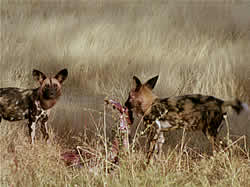 |
Wild hunting dogs are about the size of a German Shepherd dog. The hair is fairly short with irregular black blotches on a white or sandy-yellow background. No two individuals have the same colour pattern but in most cases the tail has a bushy white tip. A wild dog comsumes more food per body mass than a lion. Because they are so active, they will kill every day where possible. When setting out to hunt they usually move in single file, but soon tend to spread out in a formation more useful for locating resting antelope. their speed varies from 50 km/h to as much as 65 km/h. When nit hunting they rest up or trot along at about 8 km/h. In this way they can cover great distances in a day. They prey heavily on the females of the antelope species - in particular parturient females - and new-born young.Wild dogs lack strong jaws and teeth as well as sharp, powerful claws with which to catch and hold down a prey animal. They kill their prey by tearing it apart. One or two dogs choose the prey while the others trail. While some members of the pack follow the antelope, others will cut across the arc and the quarry will suddenly find itself surrounded by dogs.They usually give up the chase if they do not run down their prey within about 3 kms. Evidence indicates that wild dogs usually select old, injured or sick animals, especially if the prey is large. The average pack size is 8-11, but packs of up to 50 dogs have been reported. Even when the whole pack is crowded around a kill, there is very little strife. Growling and snapping - characteristic of feeding lions - is virtually non-existent.Gestation period is usually about 70 days and 2-8 pups are usually born but as many as 15 have been reported. Pup mortality is very high as very young pups are susceptible to disease. Weaning may commence at 3 weeks but the normal weaning age is about 2 months. Wild dogs care better for their young than many other predators. Both male and female regurgitate food for the pups. When young ones are about 10 to 12 weeks old, the adults leave the den area, followed by the young. Weaklings that cannot keep up with the pack are left to their fate. They either starve to death or are killed by predators such as hyena. |
ZEBRAS |
 |
Zebras are stockily built members of the horse family. The females are slightly heavier than the males. their most striking feature is the pattern of black stripes on a white or buff background. There is an upright mane of stiff hairs along the neck to the shoulders. The legs are lightly striped. No two individuals have the same markings.Zebras are extremely adaptable and this can be seen in the fact that they are always fat and well-nourished. Zebras use their teeth to feed and can therefore graze down to siol level, and at times, even dig up corms and rhizomes during times of drought. They prefer open grassy plains and savanna with fairly short grass. They are very dependent on water and do not wander very far from waterholes. They drink daily.Zebras are highly sociable animals living in family groups which usually consist of an adult stallion and a couple of mares with their offspring. Because they are highly gregarious, they are often seen in company with wildebeest, impala, waterbuck and kudu.Zebra are chiefly preyed upon by lions which account for more than 90% of zebra kills. To a lesser degree, leopards, cheetah, hyena and wild hunting dogs account for a small opercentage of kills - usually non-adults. They are not very sensitive to disease.Zebra stallions fight viciously for mares but fatalities are rare. They kick, chop and bite each other with much noise and kicking up of dust! |
|
|


